Suitable for alpine slides and ridges
Lobelia varieties with photos and descriptions:
 |
Erinus
Description:
Popular varieties: Lobelia Emperor Willy, Crystal Palace, Crystal Palace |
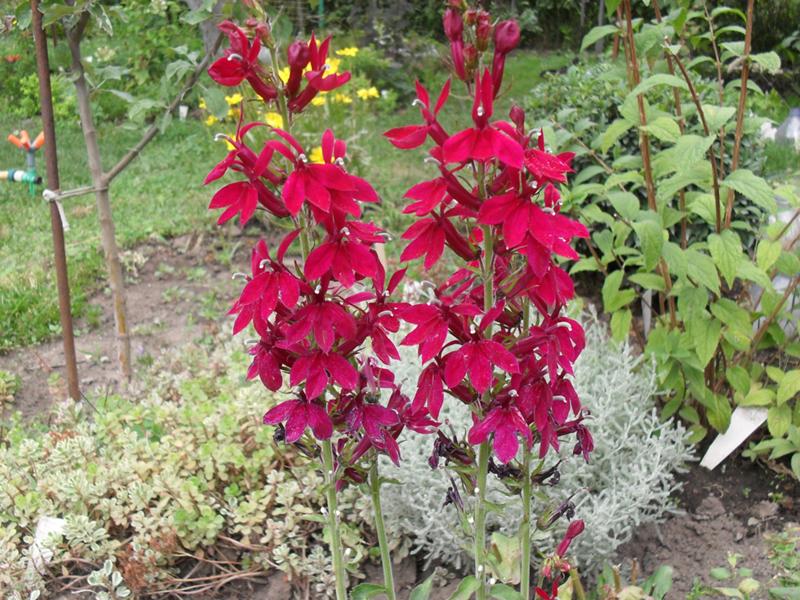 |
Cardinalis or Purple
Description:
|
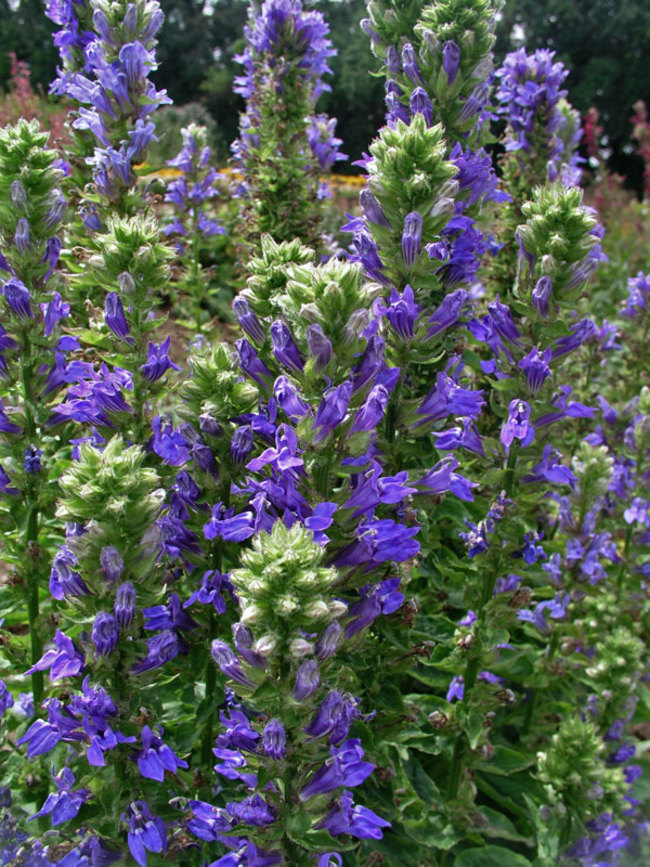 |
bird home ‘)); Description:
|
 |
Red perennial Russian princess
Description:
|
 |
Lobelia white
Description:
|
 |
Lobelia bush Riviera
Description:
|
 |
Lobelia cascading or climbing
Description:
|
How lobelia propagates by seeds
The most common breeding method is seed. It is recommended to grow lobelia in a seedling way, since the seedlings are very fragile and develop slowly. Self-seeding is also characteristic of the flower.
Note! Seedlings from such seeds in the next season bloom later than the specimens planted on seedlings
Growing from seeds
Novice gardeners should know a few tricks of sowing lobelia seeds for seedlings. Being unpretentious in adulthood, it requires painstaking care.
The recommended sowing period is from February to April. Plants planted in January require additional lighting.
As a landing container, you can take:
- peat tablets;
- seedling cassettes;
- disposable cups;
- plastic packaging for food, such as yoghurt.
The container must have drainage holes.
The culture prefers loose, non-acidic soils. For planting lobelia, soil can be purchased in stores or prepared independently from:
- sand;
- turf land;
- humus.
The soil is steamed or calcined in the oven, treated with a weak solution of potassium permanganate.
Since the seeds are very small, they are mixed with sand for planting and poured onto the surface of the soil. Another way is to use peat tablets. They are soaked in water, after which depressions are made and several seeds are placed inside.
Seedling care
The container with crops is covered with glass, kept in a bright and warm place at temperatures from +18 to +22 ° С. Ventilation is carried out regularly to protect against fungus. Seedlings appear in 7 days.
Seedlings are very fragile. How lobelia is taken care of:
gently watered with a syringe;
open the glass daily, gradually increasing the ventilation time;
protect from drafts;
highlight;
thin out the sprouts that have reached a height of 2 cm with tweezers.
Dive and transfer
The pick is carried out 30 days after the emergence of shoots. This is done with a spoon, separating some of the sprouts and transferring them to a large container. After this procedure, the seedlings are kept in a shaded place for 2 days.

Top dressing during this period is not applied
Well-lit or slightly shaded areas with light and loose sandy or loamy soils are suitable for transplanting into open ground.
Important! The optimal time for this work is after the threat of frost has disappeared. How is the transplant carried out:
How is the transplant carried out:
Planting pits are prepared with a depth of about 20 cm, at a distance of 15 cm from each other.
Drainage is poured to the bottom.
3-4 seedlings with an earthen clod are placed in each hole.
Carefully sprinkle with earth.
Diseases and pests
To the delight of gardeners, pests and diseases bypass lobelia. The exception is slugs. They appear if you are growing a plant in the open field near a pond. Various methods are used to combat them, for example:
 Slug on lobelia stalks
Slug on lobelia stalks
- Traps. In the evening, place more damp objects in the garden: bags, pieces of plywood, paper, cabbage leaves are suitable. By morning, a decent amount of pests will be taken under them.
- Beer baits. Bury a glass half full of the intoxicated drink in the ground. The main thing is that the slugs can get close to him. They also put bait in the evening.
- Sharp fences. Place fences 5-6 cm high around the lobelia, made of nutshells, granite chips, pieces of tin.
- Chemical protection. Slugs do not like mineral fertilizers and calcium. However, do not overdo it with them so as not to harm the flowers.
If too much watering is used when growing lobelia, the stems at the roots can become covered with white mold. With a moisture deficit, they become curved, and the leaves curl up. The best way to prevent problems is proper care and water balance.
Reproduction methods
You can plant a flower by seeds and cuttings.
Seed breeding
Lobelia seeds are planted in the ground just like any other seed.
When self-collecting ampel flower seeds, the grown plants may differ from the parent plant.
This applies to hybrid plants. In this regard, it is better to breed hybrid varieties by means of cuttings.
From the video you will learn how to grow lobelia from seeds:
Cuttings
- For grafting, already adult bushes are taken. The color is dug out together with the root system, without clearing it from the soil. After that, they are transplanted into a flowerpot for wintering indoors. The flowering process can last until frost, then a two-month dormant period. Lobelia is placed in a cool place and stop watering abundantly.
- By the end of February, the flower releases young twigs. Add fresh soil to the flowerpot, and distribute the runners in different directions. A little later, root-appendages will appear at the base. They must be cut off and placed in separate containers.
- When the "kids" reach 4-5 cm, they pinch them to get several young plants from the cuttings at once. In May, they are placed in open ground.
The cultivars and varieties that are most successful gardeners
Gardeners prefer to decorate their plots with the varieties presented below.
Lobelia, the cultivation of which is first carried out for seedlings, then transferred to open ground
Lobelia brilliant (Lobelia fulgens)
Ornamental culture with long erect shoots, the height of which reaches 70 cm. The leaf plates are narrow, the flowers are large, collected in inflorescences-brushes. Their color is red.
Lobelia Dortmanna
In nature, the variety is on the verge of extinction. It is found near rivers and lakes, sometimes grows in shallow waters.
For reference! The blue and snow-white blossoming flowers of Dortman's lobelia are shaped like bells.
Lobelia Gerardii
A tall specimen reaching 1.2 m in height. It has bell-shaped flowers of lilac and purple hues. The most popular variety of Gherardi lobelia is Vedrariensis.
Lobelia purple (Lobelia cardinalis)
Differs in strong shoots, towering 1 m above the ground. Inflorescences are original, sultanoid or spike-shaped. Emerald foliage.
Lobelia, whose flowers are scarlet, can be grown as a perennial. She feels good near water bodies.
Lobelia blue (Lobelia siphilitica)
Perennial with purple or bluish flowers, collected in spike-shaped inflorescences. It is a tall shrub with straight shoots. Often used to breed hybrid varieties.
Additional Information! On the basis of this variety, breeders received the compliment variety, beloved by gardeners.
Lobelia sessile
In its natural habitat, it lives in the Far East and Siberia. It is a poisonous plant. Reaches a height of 1 m. Shoots are straight and thin, the leaves are elongated, lanceolate, with a jagged edge.
The flowers are distinguished by a pale blue tint. Flowering becomes especially abundant at the end of summer.
Lobelia erinus
Herbaceous variety with flexible shoots and oblong-rounded leaves. It is considered the most common among all lobelias grown in flower beds. The flowers are modest in size, up to 2 cm in diameter. The color is most often white or blue. Blooms profusely from June to September. There are columnar, creeping and compact forms.
Lobelia valida
A low plant up to 40 cm in height, growing in the form of a spreading bush. Its foliage and shoots are painted in a juicy green hue, and the flowers are pink, purple or lilac with a white eye.
Does not remain in the ground for wintering
Lobelia tenuior
Graceful, profusely blooming lobelia, its flower blooms on a refined shoot. A wonderful inhabitant of flower beds and mixborders, pots. Forms many lilac, cornflower-blue or pinkish buds. The variety is grown as an annual.
Planting process
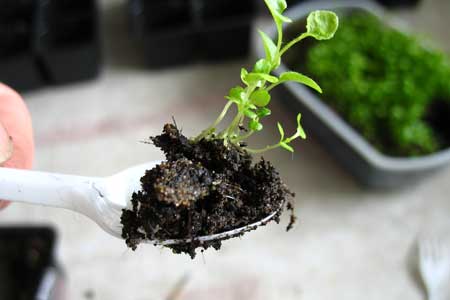
The technology of planting lobelia by the seedling method is not very complicated, even a beginner can handle it. A step-by-step algorithm for this process:
- The soil is placed in the container, then it is slightly moistened with warm water and thoroughly loosened. At this stage, it is recommended to add a little growth stimulant to enhance the germination of the seedlings.
- Due to the fact that the seeds are small, they are mixed with sand or tea leaves, and then evenly sprinkled on the top layer of soil. It is categorically impossible to add a substrate from above - this will slow down the growth rate of plants.
- Snow is poured onto the ground, which gradually melts and draws in the seeds after it. After that, the container with the seedlings must be covered with foil and placed in a warm and dry place.
- The first shoots appear in 5-10 days from the moment of sowing. After that, the film can be removed or ventilated at least 3 times a day for 10-15 minutes. The cover can be completely removed when the seedlings get stronger and grow slightly.
- The pick is not carried out. A transplant to a permanent place in the open field can be carried out starting from the second half of May. The plant is planted in individual pits up to 25 cm deep.The optimal distance between the bushes is 15 cm.At the bottom of the hole, it is imperative to lay drainage, which is used as expanded clay or small pebbles.
- After transplanting, the seedlings are watered abundantly, and the first feeding can be carried out no earlier than 10 days from the moment of the pick.
In addition, it is widely practiced to plant lobelia with grown seedlings, which can be easily purchased at a flower shop. The planting algorithm in this case is practically the same, but you need to slightly increase the planting hole so as not to damage the root system.
Do I need to pinch ampelous lobelia
Pinching the flower is not necessary. But thanks to this, lobelia bushes can be more fluffy and bushy. This is especially recommended if there is still enough time left before planting in a permanent place and the seedlings outgrow. Pinching is done when the flower sprouts reach five centimeters.
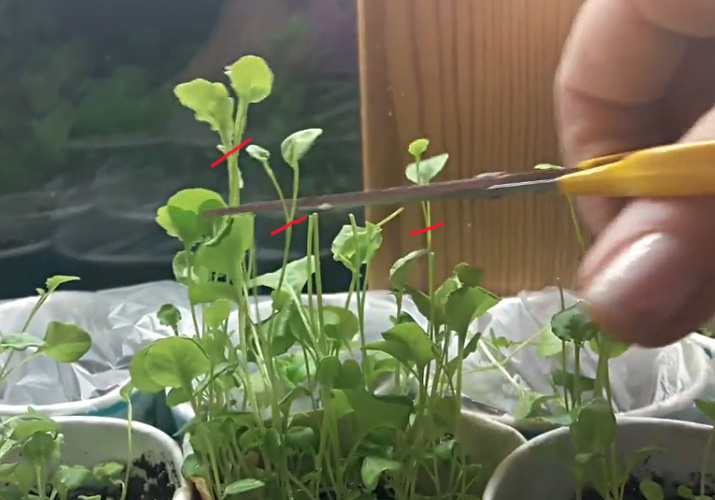
Pinching process
In conclusion, it should be noted that ampelous lobelia is quite easy to care for, the main difficulties can be experienced only during sowing. Experienced gardeners also recommend choosing seeds in granules for more convenient sowing. If the plant is planted correctly and given proper care, then you will get a lush flowering throughout the summer, up to severe frosts.
Lobelia in a flowerbed goes well with other plants and feels great in boxes or pots. Previously, lobelia was used in medicine - the "Lobelia syphilitic" variety was used to treat the disease of syphilis, now it is used as a decorative decoration of a flower bed. So the functions of this plant are quite varied.
Lobelia types
The ability of lobelia with a flowering carpet to plastically participate in the creation of all kinds of landscape compositions puts it among the recognized floral beauties such as roses and hydrangeas, irises and periwinkles.
The genus of this plant has more than 400 species, below we present a list of its most popular representatives.
- The genus includes over 400 species. But we will name some of them:
- Lobelia purple, or Lobelia cardinal, or Lobelia blood-red - Lobelia cardinalis L.
- Lobelia Dortmanna - Lobelia dortmanna L.
- Lobelia erinus, or Lobelia garden, or Lobelia black, or Lobelia border, or Lobelia blue - Lobelia erinus L.
- Lobelia senegalese -Lobelia senegalensis
- Lobelia inflated, or Lobelia inflata, or Indian tobacco - Lobelia inflata L
From all that has been written, it follows that growing Lobelia and caring for it, both ampelous and open ground, is simple, but requires delicacy at the stage of transplanting and watering seedlings. Otherwise, it is quite unpretentious and capable of restoring cut shoots and a long-flowering plant. Colorful, multi-colored, lush and combined with other tall ornamental plants, it easily fits into any landscape composition and will delight others with its excellent decorativeness for a long time.
Types and varieties of lobelia with photos and names
There are about 300 types of lobelia. Consider the most popular cultivated species and varieties.
- Perennial. They are plants with erect shoots, spike-shaped inflorescences.
Lobelia fine Lobelia speciosa

Lobelia fine Lobelia x speciosa grade Hadspen Purple photo
The plant is 60-90 cm high with large bell-shaped flowers (up to 3 cm in diameter). The color of the flowers is blue, pink, red.
Lobelia fiery or brilliant Lobelia fulgens
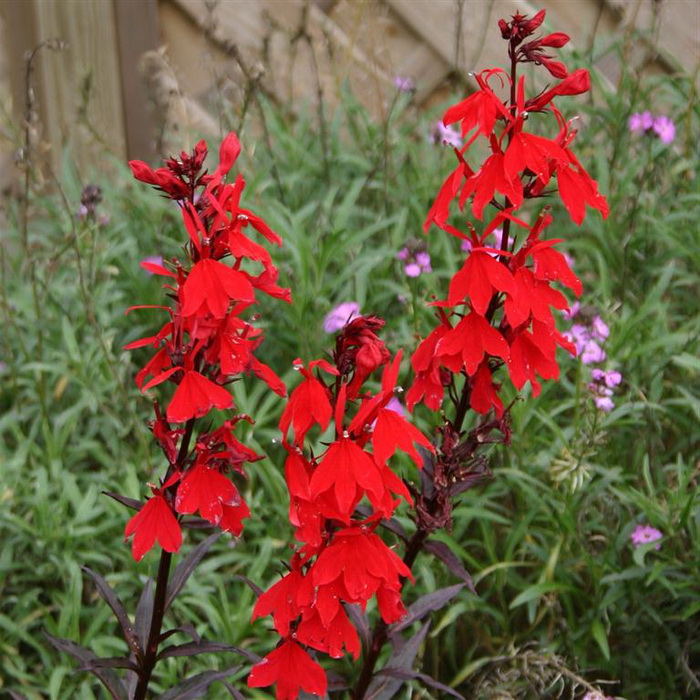
Fire lobelia or glitter Lobelia fulgens 'Queen Victoria'
Reaches a height of 75 cm. Corollas are bright red or pink in color. The Queen Victoria variety is popular - the height is 1.5 m.
Lobelia purpurea or cardinal Lobelia cardinalis

Lobelia purpurea or cardinal Lobelia cardinalis photo
Stem height is about 1 m. Corolla of coral color.
Lobelia Dortman is a plant 60-80 cm high with rare expressionless flowers of white or blue color.
Lobelia gerardii

Lobelia Gerardi Lobelia x gerardii cultivar 'Hadspen Purple' photo
Very frost-resistant (withstands up to -29 ° C). The height is 1.2 m.Corollas are blue or purple.
Lobelia sessile - spike-shaped inflorescence consists of corollas of blue or lilac color.
Lobelia Erinus or blue, border, black
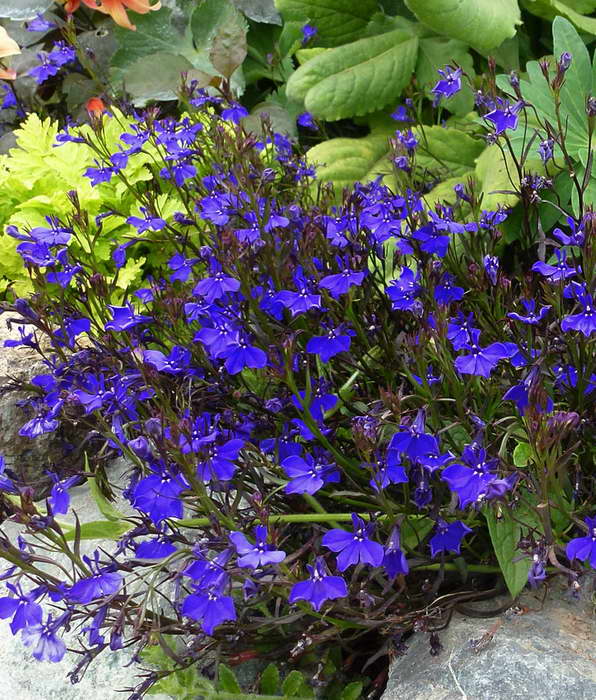
Lobelia Erinus or blue, curb, black Lobelia erinus cultivar 'Monsoon' photo
The height is no more than 40 cm, the diameter of the flower reaches 2 cm.
There are 5 forms:
- Lobelia compact - erect shoots 10-15 cm high.
- Lobelia is spreading - the length of the climbing shoots is 25-30 cm, the bush grows in width by 10-15 cm.
- Dwarf lobelia - no more than 10 cm high.
- Erect lobelia is a columnar bush with stems 25-30 cm high.
- Lobelia ampelous - curly shoots about 40 cm long.
Varieties:

Lobelia Crystal Palace Lobelia Crystal Palace in landscape design photo
Crystal Palace is a 15-20 cm high bush with blue-violet flowers.

Lobelia grade Emperor William (Emperor Willie)
Emperor William is a lush bush about 10 cm high, flowers of a sky-blue hue.
Miss Klibran is a ground cover plant with a height of 10-15 cm, a pillow diameter up to 30 cm. Flowers of a blue-violet shade with a white eye.
Cambridge Blue - stems no more than 10 cm long. Flowers of a cold blue hue.
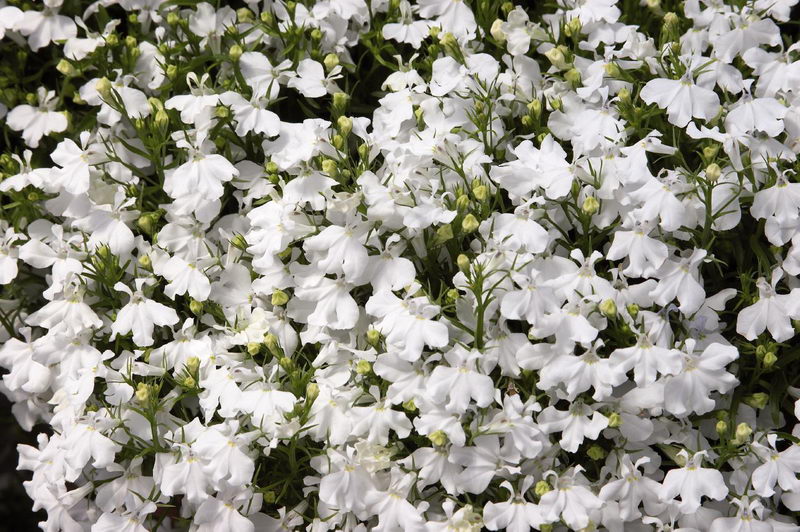
Lobelia erinus cultivar White Palace Lobelia erinus White Palace photo
White Palace - the height of a dense bush is 10-12 cm, the flowers are snow-white.
Sapphire is an ampelous plant with shoots 25-30 cm long. Flowers are bright blue with a white spot on the lower petal.
Blue fountain (Fountain Blue) - has climbing shoots 30-35 cm long.
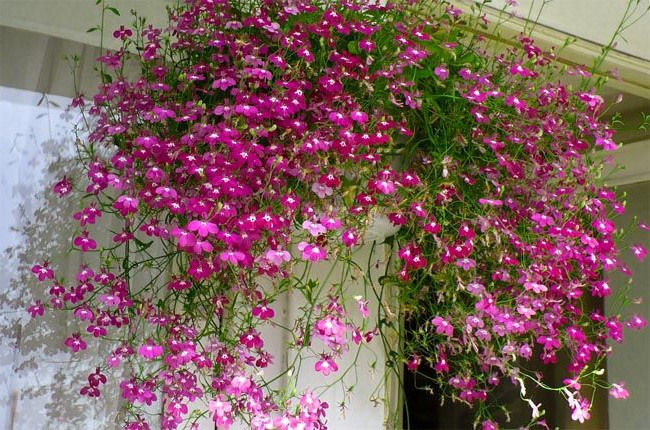
Lobelia ampelous grade Red cascade red cascade photo
Red cascade - the falling shoots are 35-40 cm long. The color of the flowers is lilac.
Regatta rose is a dwarf plant. The flowers are bright pink with a white eye.
Riviera Sky Blue - the bush is 15-17 cm high. The flowers are light blue.
Lobelia strong Lobelia valida
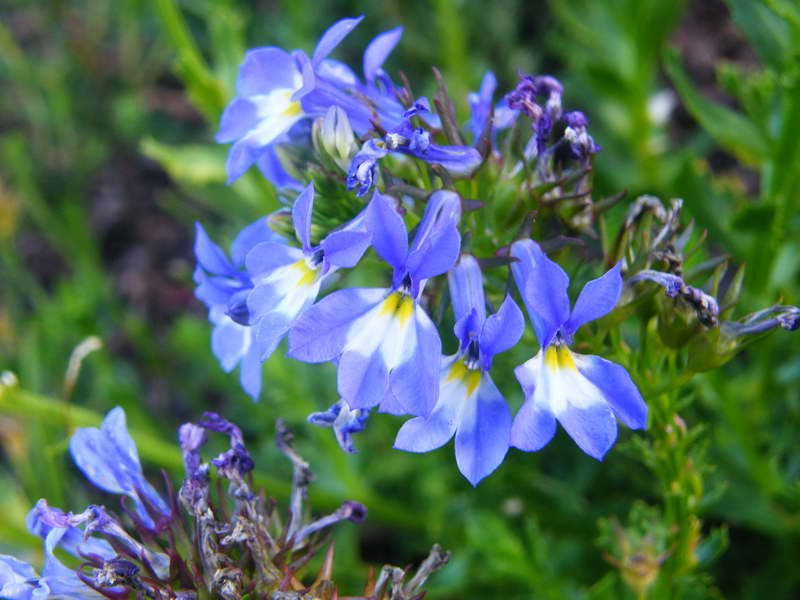
Lobelia strong Lobelia valida photo
It has powerful thickened stems up to 40 cm long. Compact bushes are covered with blue, purple flowers.

Lobelia the thinnest or most delicate Lobelia tenuior photo
Length of thin stems reaches 35 cm. Flowers are white, lilac, blue.
Reproduction of lobelia
We repeat that in the temperate climate of Russia, this flower is preferred to grow as an annual plant. Most often, seed propagation is used for breeding. Less often - cuttings and division of bushes.
Lobelia: growing from seed
This method is considered the simplest, because it is not difficult to get seedlings from plant seeds:
- Seeds obtained from seed pods do not require special storage conditions.
- They are very small, so it is best to use an ordinary toothpick to sow them.
- Sowing of seeds is usually carried out at the end of February. However, this can be done any day before early April.
- Sowing seeds is best done in special containers. Usually gardeners for this purchase special cassettes with peat tablets in flower shops.
- Lobelia seeds grow best in loose and light soils. Therefore, when planting them, humus cannot be added to the soil. To enrich it, it is better to use special soil mixtures.
- Before planting, a small layer of drainage from small pebbles should be placed in each container. Only then can the potting mix be poured.
- After planting the seeds, water the soil well and cover the container with plastic wrap.
- In the future, before the first shoots appear, the crops should be regularly ventilated. In addition, in the room with containers, the air temperature must be maintained at 21 ° C.
- The first shoots usually appear 10 days after sowing.
- After the appearance of several leaves, individual seedlings can be transplanted into larger containers. One container should not contain more than 4 seedlings.
- Before planting in open ground, seedlings should be regularly watered and maintained at a temperature of 18 ° C.
Propagation by cuttings
This method of growing lobelia is used when they want to be sure that the young plant will receive all the maternal characteristics.
- Before winter, the strongest plants should be transplanted into pots and brought home or into a cool greenhouse. Until spring, they need to be provided with decent care.
- In spring, cuttings with a length of at least 8 and no more than 10 cm are cut from the bushes of the plant. The blanks must be placed in a container with a root former.
- After the roots appear, you can plant the cuttings in separate plastic containers.
Reproduction by division
This method is the least popular in our country, because we prefer to grow lobelia as an annual plant. The essence of this breeding method is to dig up the plant in the spring and divide it into several parts, which are then transplanted into separate planting holes.
Biological features [edit]
The plant belongs to perennial herbaceous plants, but does not winter in the conditions of Central Russia, it is usually grown as an annual plant.
Lobelia is a light-loving, shade-tolerant and moisture-loving plant, quite cold-resistant (withstands a minimum temperature of 7 ° C). Prefers open, unshaded places with well-drained sandy and loamy soils of medium moisture. Excessive waterlogging of the soil can lead to rotting of the root system. On soils with an excess of organic fertilizers, plants vegetate intensively, abundantly developing shoots and leaves to the detriment of flowering.
In hot dry weather, flowering almost stops. After the first flowering, if the shoots are cut at a height of four to five centimeters from the ground, new tillering and secondary abundant flowering can be caused. To obtain a compact and dense bush, its top can be pinched when it reaches a height of 2.5 cm. It can be relatively easily transplanted in a flowering state. With enough heat and moisture, lobelia blooms until frost. The plant can be transplanted into a pot and used as a houseplant.
Propagated by seeds. 1 g contains 30-50 thousand seeds. Seeds remain viable for three to four years. It takes about 0.05 g of seeds to get 100 plants. The optimum temperature for germination is 20 - 25 ° C. A plant with a slow development cycle. Blooms 70 - 80 days after sowing.
Lobelia is a cross-pollinated plant with proterandic flowers. Pollinated by bees and butterflies.
When several varieties of lobelia are grown on the same farm, to maintain their purity, spatial isolation between plots of at least 200 m is required.
Diseases and pests have not been identified. There is an indication in the literature that aphids and plant bugs bring harm to the plant. Lobelia can be affected by rot, real or powdery mildew. Rust, smut and spotting sometimes appear on the leaves.
Lobelia care during flowering in the garden
Lobelia is a cold-resistant, light-loving and moisture-loving plant. It grows and thrives best in a sunlit place with sufficient moisture. The soil loves loose, nutritious, but without an excess of organic fertilizers. Caring for her does not present any particular difficulties, however, it requires compliance with some rules:
- Watering
- Loosening and weeding
- Top dressing
- Pruning
Watering.
The root system of lobelia is not located at the surface, but grows vertically down to a depth of 10-15 cm. Such a root system does not place high demands on irrigation. Just spill the soil to this depth and do not let it dry out.

If you grow flowers in pots or in boxes, then on hot days the moisture from them evaporates much faster, such plantings need to be watered at least once a day.
Loosening and weeding.
Loosening is a very important operation for maintaining the microclimate of the root system of any plant and lobelia is no exception. No wonder this process is called dry irrigation. The fact is that after watering or rain, a crust forms on the soil surface, preventing air from reaching the roots, at the same time, water penetrating deep into, forms capillaries through which moisture begins to actively go back out. It turns out a double harm - there is no air flow and there is a release of moisture.And if the soil is clay, then the outflow of moisture may stop, then rotting of the roots occurs.

Loosening destroys the surface crust and capillaries for moisture release, makes the soil looser and more accessible for air flow. Since the roots of lobelia grow vertically downward, it must be loosened to a depth of 4-5 cm around the plant. Also weed.
Top dressing.
The best fertilizer for lobelia is vermicompost. It contains a lot of macro and microelements, as well as phosphorus and potassium, at the same time there is little nitrogen. This is the best combination of elements. The amount of vermicompost for the whole season per plant is 150g. Divide this amount into three parts. Carry out the first feeding one week after transplanting into open ground, the second before the first wave of flowering, the third after the first wave of flowering and pruning of plants.
Top dressing with potash fertilizers, such as potassium sulfate, provokes abundant flowering.
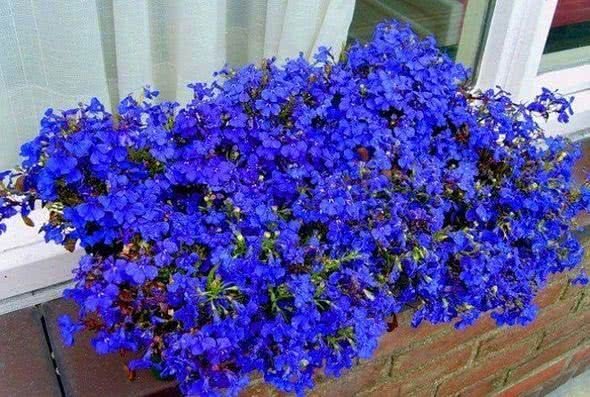
At the same time, lobelia looks beautiful, there is a lot of color, but I am not a supporter of such dressings, it's like doping for athletes. Better to get a healthy, harmoniously grown plant.
Pruning.
Pruning is a very important operation for a beautiful shrub. At the same time, you provoke dormant buds to awaken, from which processes begin to grow
The bush begins to thicken, which in turn leads to more flowers.
Pruning can be carried out several times per season, the plant easily tolerates this operation. At the same time, it is not customary to cut and pinch ampelous species, but she also tolerates it easily. It all depends on what you want to get. A pruned bush looks shorter and more luxuriant, an uncircumcised shrub grows longer and has less color.

The height of the plant to which it is pruned depends on the variety. In general, it is customary to cut at a height of 5-10 cm, and the main thing is to cut the growth point. I repeat again, it all depends on which bush you want to get, either shorter or longer. And don't be afraid to trim a little or a lot, lobelia has no such concept.



